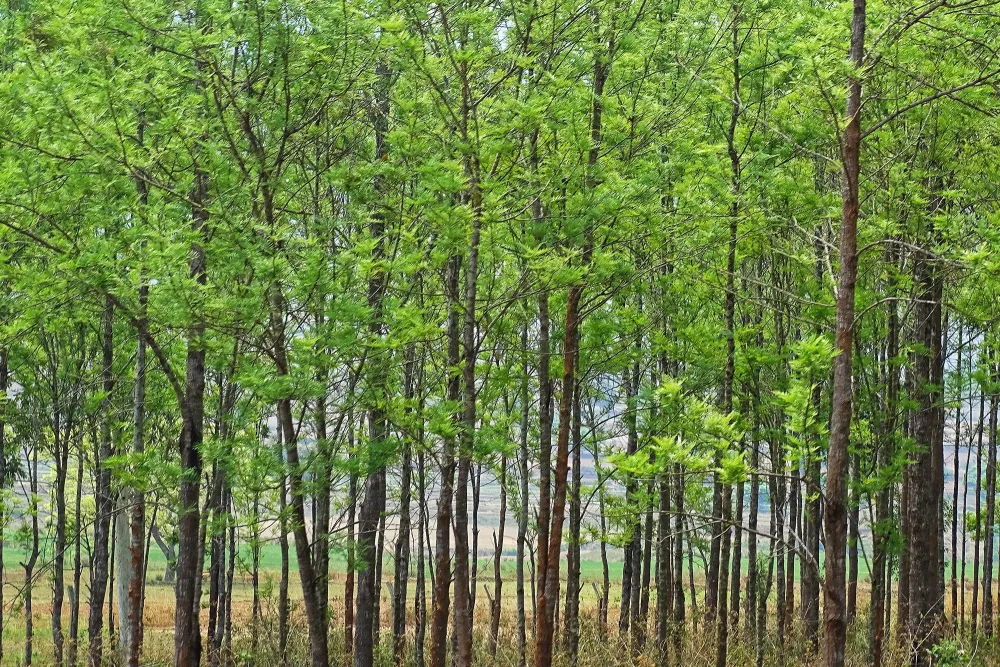Now live: The 2025 Canopy Report. Learn how Americans see trees. GET THE REPORT
Bulletin
How to Manage Woodlots and Tree Plantations
Many landowners have natural woodlands or odd-shaped areas of land that could be profitable as woodlots or tree plantations. Well-managed woodlots or plantations can provide revenue or other economic value from timber or nut sales, fuelwood, or control of runoff.

They can also provide enjoyment of wildlife and natural beauty.
Timber Plantations
Trees grown for timber may require 60 years or more to reach harvestable size. Although with good management, some species can be harvested in as little as 25 years. Good timber trees can produce high dollar returns on the land.
Veneer
Mature, high-quality trees can be processed into thin layers of wood that are used for quality furniture and plywood. Veneer trees will usually yield several times more value than trees of lower quality. Lumber, Pulp, & Fiber
Lesser-quality trees can be grown for lumber, plywood, or posts. Some species can be harvested for pulpwood to meet the demand for paper products. Fuelwood Plantations
Trees grown for fuelwood are usually harvested in as little as five or six years, lessening the time needed to produce a marketable crop.
Heat Values
In general, hardwoods have high heat values per cord and are sold for home heating. For industrial fuelwood heating plants or other large operations, species such as hybrid poplars produce more tons of wood per acre per year.
Harvesting
Fuelwood can be harvested while thinning a timber plantation or cut as complete sections of a plantation. Trees for new-technology fuelwood heating/cooling plants are harvested in as little as 5 or 6 years, cut at ground level, with stumps left to resprout.
Nuts
Black walnut is widely grown for both its nuts and its highly prized wood, and odd-shaped pieces of land unsuitable for crops are often ideal as walnut planting sites. Other nut species, such as pecans, hazelnuts and almonds, are grown in areas where climate and soil conditions are favorable.
Christmas Trees
Christmas trees may provide a high return on otherwise marginal agricultural land, but only if a strong, accessible market exists. Be prepared for the labor and time needed to provide the annual pruning and maintenance Christmas trees require.
Most woodlots are not managed as renewable resources, but are harvested periodically with little thought to improving the condition of the woodlot. With a little effort, a woodlot can yield ongoing benefits. One of the first management steps is to remove defective, damaged, or otherwise undesirable trees, leaving space to encourage growth of the more desirable species. Trees to consider removing include:
Diseased — with evidence of serious decay, large wounds, or hollow places.
Cull trees — of merchantable size but unmarketable because of excessive defects.
Vines — if left uncontrolled, they may reduce growth by shading and increase the risk of top breakage.
Weed trees — species with little or no value for the intended objective. Remember, a weed tree for timber production may be valuable for wildlife.
Wolf trees — those occupying more space in the forest than their timber value justifies.
Poorly formed — with main stems forked or badly crooked.
Damaged or scarred — with overgrown branch stubs or other evidence of storm breakage, fire, or mechanical injury.
One of the goals of woodlot management is to obtain the number of trees per acre that will most effectively utilize the forest’s growth capacity. A stand with too few trees should be managed to encourage new growth of desirable species; stands that are too crowded should be thinned.
